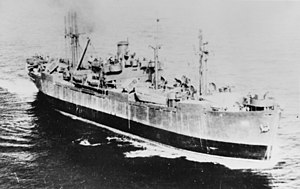Service history
Completing shakedown 5 December, Rotanin loaded her first combat cargo and embarked her first military passengers at Port Hueneme, California, and on 12 December, sailed for Nouméa. Arriving 5 January 1944, she carried troops and cargo to Guadalcanal, then, on 27 December, continued on to the Russell Islands. By 2 February, she had discharged all cargo and was underway back to the Guadalcanal-Florida Island area. From then until March, she carried cargo and personnel throughout the Bismarck Archipelago, the Solomons, the Fijis, and the New Hebrides. In April, she completed a run to Auckland, New Zealand, and in May, she moved supplies to Manus. She then resumed runs in the Solomons-New Hebrides-Fiji area.
Supporting the Allied invasion forces
In August, Rotanin shifted to the Marshalls-Marianas area and at the end of the month she moved further west, to Ulithi. In October, she carried United States Army units to the Palaus, embarked Marines there, and transported them to the Russells. In November, she returned to operations in the Marianas, extended them to the Carolines, and in January 1945, returned to Nouméa. February and March took her back to Micronesia and New Zealand. In April, she was in the Solomons, and, in May, she took on Army supplies and reinforcements for the Okinawa campaign. Arriving off the Hagushi beaches on 21 May, she completed offloading by the end of the month and on 31 May, she steamed east.
End-of-war activity
During June and July, Rotanin again operated in the Marshalls and Marianas. On 28 July, she headed for Hawaii and the west coast. En route when hostilities ceased, she arrived at San Francisco, California, on 17 August. In October, she joined the ships assigned to transpacific operations to ferry occupation troops to Japan and Korea and to return veterans to the United States.

USS Arided (AK-73), a Crater-class cargo ship, is the only ship of the US Navy to have this name. She was named after Arided, the other name of Deneb, the alpha star of constellation Cygnus.
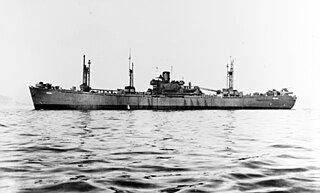
USS Naos (AK-105) was a Crater-class cargo ship commissioned by the US Navy for service in World War II. Naos was named after the star Naos, in the constellation Puppis. She was responsible for delivering troops, goods and equipment to locations in the Asiatic-Pacific Theater.
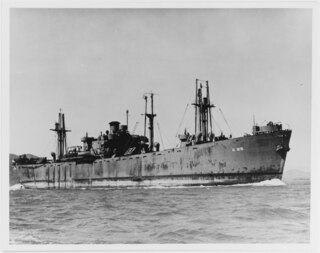
USS Murzim (AK-95) was a Crater-class cargo ship commissioned by the US Navy for service in World War II. She was named after Murzim, the star in constellation Canis Major. Murzim was manned by United States Coast Guard personnel and was responsible for delivering troops, goods and equipment to locations in the Asiatic-Pacific Theater.

USS Cassiopeia (AK-75) was a Crater-class cargo ship in the service of the US Navy in World War II. She was the only ship of to bear this name. She is named after the Northern Hemisphere constellation Cassiopeia.
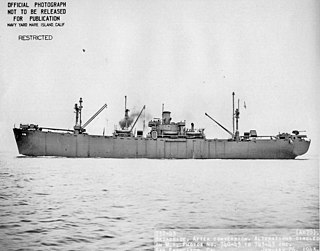
USS Deimos (AK-78) was a Crater-class cargo ship in the service of US Navy in World War II. It was the first ship of the Navy to have borne the name Deimos, after one of the moons of Mars.

USS Lyra (AK-101) was a Crater-class cargo ship in the service of the US Navy in World War II. It was the only ship of the Navy to have borne this name. It is named after the constellation Lyra.

USS Crater (AK-70) was the lead ship of her class of converted liberty ship cargo ships in the service of the US Navy in World War II. She was first named after John James Audubon, an American ornithologist, naturalist, and painter. She was renamed and commissioned after the constellation Crater, she was the only ship of the Navy to bear this name.

USS Adhara (AK-71) was a Crater-class cargo ship in the service of the US Navy in the Pacific theater in World War II. Named after the star Adhara in the constellation Canis Major, it was the only ship of the Navy to bear this name.

USS Celeno (AK-76) was a Crater-class cargo ship in the service of the US Navy in World War II. Named with a variant spelling of the star Celaeno in the constellation Pleiades, it was the only ship of the Navy to bear this name.

The USS Alnitah (AK-127) was a Crater-class cargo ship in the service of the US Navy in World War II. Named a spelling variation of the star Alnitak in the constellation Orion, it was the only ship of the Navy to bear this name.

USS Draco (AK-79) was a Crater-class cargo ship commissioned by the US Navy for service in World War II. Named after the constellation Draco. She was responsible for delivering goods and equipment to locations in the war zone.

USS Cor Caroli (AK-91) was a Crater-class cargo ship commissioned by the US Navy for service in World War II and manned by a US Coast Guard crew. She was named after Cor Caroli, the brightest star in constellation Canes Venatici. She was responsible for delivering goods and equipment to locations in the war zone.

USS Mintaka (AK-94) was a Crater-class cargo ship commissioned by the US Navy for service in World War II. She was named after Mintaka, a star in the Orion constellation. Mintaka was crewed by United States Coast Guard personnel and was responsible for delivering troops, goods and equipment to locations in the Asiatic-Pacific Theater.

USS Sterope (AK-96) was a Crater-class cargo ship commissioned by the U.S. Navy for service in World War II. She was responsible for delivering troops, goods and equipment to locations in the war zone.
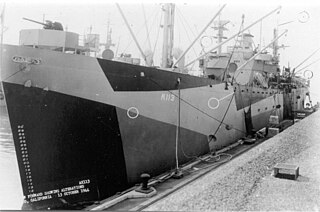
USS Rutilicus (AK-113) was a Crater-class cargo ship commissioned by the US Navy for service in World War II. She was responsible for delivering troops, goods and equipment to locations in the Asiatic-Pacific Theater.
USS Alderamin (AK-116) was a Crater-class cargo ship commissioned by the U.S. Navy for service in World War II, named after Alderamin, the alpha star in constellation Cepheus. She was responsible for delivering troops, goods and equipment to locations in the war zone.

USS Matar (AK-119) was a Crater-class cargo ship, converted from a Liberty Ship, commissioned by the US Navy for service in World War II. She was first named after Napoleon B. Broward, an American river pilot, captain, and politician; he was elected as the 19th Governor of the US state of Florida. She was renamed and commissioned after Matar, a binary star in the constellation of Pegasus. She was responsible for delivering troops, goods and equipment to locations in the war zone.

USS Lesuth (AK-125) was a Crater-class cargo ship commissioned by the US Navy for service in World War II. Lesuth was named after the star Lesuth in the constellation Scorpius. She was responsible for delivering troops, goods and equipment to locations in the Asiatic-Pacific Theater.

USS Megrez (AK-126) was a Crater-class cargo ship commissioned by the US Navy for service in World War II. Megrez was named after Megrez, a star in the constellation Ursa Major. She was responsible for delivering troops, goods and equipment to locations in the Asiatic-Pacific Theater.

USS Livingston (AP-163/AK-222) was a Crater-class cargo ship built for the US Navy during World War II. She was responsible for delivering troops, goods and equipment to locations in the Asiatic-Pacific Theater.
